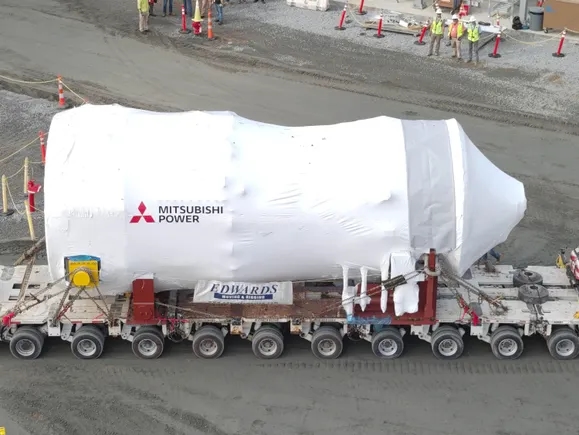Georgia Power receives natural gas turbine as delays loom

- For the first time in a decade, Georgia Power is set to install a natural gas turbine at its Plant Yates. The utility said it placed an order for three turbines around the time it was putting out its 2023 Integrated Resource Plan update — right before wait times for gas turbine orders began to steadily climb.
- Georgia Power said it plans to bring the first unit online by December 2026, and bring the next two units online in 2027. Once the three units are in service, they’ll generate a combined 1.3 GW.
- The delivered turbine is a Mitsubishi Power M501JAC simple-cycle turbine which weighs 350 tons — one of the largest turbines on the market, said Bobby Noble, senior program manager of gas turbine research and development at the Electric Power Research Institute. Right now, Noble said, smaller turbines are becoming more appealing for anyone who wants to deploy gas, as the wait times aren’t as bad.
If you ordered a large turbine “two to three years ago, maybe you were only looking at a two-and-a-half to three year wait,” Noble said. “At the level we are now — I've heard orders having a lead time as long as seven years, but most of them are in that five-year period.”
However, the lead time for many smaller gas turbines is only two to three years, he said, which makes them appealing for developers trying to power data centers. Order numbers for small gas turbines are “massively higher than what they've been in the past five years,” he said.
“Over the past several years, when you started to see coal retirement announcements and plans under the previous administration, the backfill for that was primarily looking at using dispatchable gas turbines,” Noble said. “From that point, you started seeing those orders pick up. And then, of course, as data centers have been booming, there needs to be a dispatchable, reliable energy source for those data centers.”
“And they're not small data centers,” he added. “You're talking hundreds of megawatts plus.”
Georgia Power said in its 2023 IRP update that deploying new combustion turbines would “provide the operational flexibility that is needed to support the integration of renewable resources and also complement non-generating battery storage resources, while providing dispatchable peaking power when needed.”
When gas is unavailable to operate the turbines, they can run instead on oil, providing a lower capacity of 1 GW to 1.1 GW. “With minor future modifications, the M501JAC is also capable of using a hydrogen mix as a fuel,” Georgia Power and Mitsubishi Power said in a Friday joint release.
The M501JAC “is an advanced class, high efficiency engine … That's the top of the line, the biggest that's available,” Noble said. “I'm sure [Georgia Power is] happy that they had their planning in place.”
Georgia Power’s Media Relations Manager John Kraft said the utility “began planning for these units as part of its 2023 IRP Update and took steps to order and reserve the equipment during that time in order to meet needed delivery and service dates for the project.”
In the release, Georgia Power said it was thanks to “efficient planning and construction timelines” that the three turbines “are expected to be online by the end of 2027 to meet new energy demand in the state.”
When it comes to solving the backlog, Noble said it is “really challenging to increase the output of gas turbines just because it touches on so many different aspects.”
Not only does a large turbine require massive amounts of material and a large space to assemble, but engineering, procurement, and construction firms are short on workforce, he said.
“I was just speaking to one of the EPCs a couple weeks ago, and a lot of these companies have 500 plus job openings right now,” Noble said.
EPRI is trying to help solve this shortage in part by continuing to examine “what can be done to extend the life of the assets that are installed, so that we can continue to have the supply that's needed and ensure the capacity is where it needs to be,” Noble said. “We look at the associated risk for how we can continue to use units past the initial intended design.”
There’s also the option of upgrading gas turbines that are already installed, he said, “so that you can potentially have more megawatts generated, making the unit more efficient, as opposed to having to install more capacity.”
utilitydive





